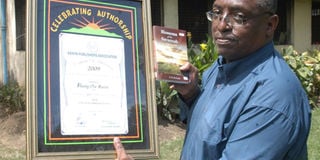Ole Kulet: Will the flowers still blossom in the savannah?

Mr Henry Ole Kulet with the trophy, certificate and the book which won him the Jomo Kenyatta Prize for Literature and a nomination for the Dublin Literary Award in 2009.
What you need to know:
- Blossoms of the Savannah explores the conflict arising between cultural values of the Maa people.
News of the demise of Kenya's cultural literary icon, Henry Ole Kulet, came as a shock to those who had embraced his ‘cultural novel’. The Kenyan literary scene has been numbed by the news of his death at a point when one of his literary masterpieces, Blossoms of the Savannah, is a set book for high school students in Kenya.
Born in Enkare-Ngusur in Narok County in 1946 to a pastoralist father, Henry ole Kulet grew up to be a celebrated writer in Kenya and East Africa.
Ironically, his father had moved them to a remote place in Ilkiremisho in the futile attempt to make him escape the influence of Western education.
His journey to success was not an easy one as he had no training in the literary field; he trained in agriculture at Egerton University, where he studied farm management and was later employed as an assistant manager with Kenya Farmers Association (KFA). He, however, quit his job in 1987 to concentrate on writing.
Amongst his popular novels are Moran No More,The Hunter, Bandits of Kibi, The Elephant Dance and Daughters of Maa, amongst others. His pet subjects include cultural erosion and environmental degradation.
Cultural values
Blossoms of the Savannah explores the conflict arising between cultural values of the Maa people and intrusive western values brought about by a world that has changed immensely in the post-colonial period. The heroine of his story is Resian, the stubborn, determined and resolute daughter of Parsimei Ole Kaelo, who has to resist the advances of the amorous and mannerless Oloisudori Lonkiyaa and the attendant oppressive Nasilan culture which encourages women to submit to the will of their men in a society that is patriarchal in nature.
When her father, Ole Kaelo, conspires to circumcise her in order to marry her off to a man who is "the age of his father”, Resian has no respite, but to run away from the two conspirators. Olarinkoi gives her a false sense of hope by offering to rescue her. Unbeknown to her, Olarinkoi plans to take her to a remote part of the village with the aim of taking her as his wife.
Resian is pained by the silence of her mother as she goes through torment with her reserved sister, Taiyo. It is only Taiyo's love and her passionate dream to join Egerton University that keeps her going. In the end, her dream is fulfilled when she meets her role model, the Emakererei, who offers her a shoulder to lean on and a shelter from a world full of Nasilan wolves. In the words of the girls of entapuka Maa school, the Savannah had blossomed.
Dilemma
Which puts us into a dilemma; with the demise of Henry ole Kulet, will the flowers in the Savannah still flourish? With Kulet's death, who will still have a sympathetic eye towards Maa culture? What will happen to the daughters of Maa now that the bandits of Kibi are taking over? Will we have morans anymore?
So many questions, so few answers. Nasilan culture will still metamorphose in the backdrop of the onslaught of modern lifestyles.
Paradoxically, his life came to an end where his story, Blossoms of the Savannah, began - in Nakuru. In a sense, his life and that of his book had gone through the full circle of life. Rest in peace Ole Kulet.




